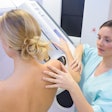
Radiologists need to familiarize themselves with breast imaging features in transgender women, including normal breast development induced by hormone therapy and breast augmentation, according to a review published August 9 in Clinical Imaging.
Dr. Thomas Lienhoop and Dr. Lauren Green from the University of Illinois said understanding the potential for breast cancer in the transgender population is important for recommending appropriate screening and providing timely diagnosis, as well as for reducing disparities.
"Transgender people are estimated to represent 0.5%-1% of the population, and that may be underestimated given barriers including stigmatization," Lienhoop told AuntMinnie.com. "Despite challenges, the research is invaluable, as transgender people have among the worst healthcare disparities in the U.S."
Multiple professional organizations have produced guidelines for breast cancer screening of transgender women. The American College of Radiology, for example, updated its appropriateness criteria in April to include transgender breast cancer screening.
In the current study, Lienhoop and Green looked at several studies in writing their review, which included benign breast lesions, breast cancer screening, and special recommendations.
Transgender women may experience benign and malignant breast lesions just as cisgender women do. Previous research has suggested that biological males transitioning to female are at increased risk for breast cancer compared with other males due to hormone use. However, the association between feminizing hormone therapy and breast cancer in transgender women continues to be investigated.
Mammography and ultrasound have found a range of breast densities for transgender women undergoing hormone therapy. A 2010 Belgian study found that breasts were judged "translucent" in 18% of women, "slightly dense" in 22%, "dense" in 38%, and "very dense" in 22% on mammography. On ultrasonography, the breasts were judged "fatty" in 36% of women, "slightly dense" in 26%, "dense" in 36%, and "very echodense" in 2%. The study authors also found significant correlation between breast density at mammography and ultrasonography.
However, no longitudinal data exists on screening transgender women for breast cancer with imaging. Lienhoop told AuntMinnie.com a lack of national geographic data is a major barrier in researching this population.
"Our efforts to provide evidence-based care currently suffer from a lack of large prospective studies, which could be improved by compiling a centralized database of cases or combining populations from multiple centers," he said.
Transgender patients face healthcare disparities related to stigma, discrimination, and lack of access. Patients may be less likely to seek medical care and return for follow-up given barriers such as lack of insurance coverage and lack of provider knowledge.
Lienhoop and Green cited a 2015 study by Bazzi et al that found transgender women with a history of at least five years of hormone therapy were less likely to adhere to annual screening mammography than cisgender women.
The researchers said breast imagers can help address barriers by maintaining a safe and inclusive environment. Examples include using gender-inclusive signage, gender-neutral colors, and gender-neutral or single-person bathrooms.
Patients should also be asked about their gender identity on intake forms and appropriate patient names and pronouns should be used, they said.
"Radiologists, technologists, and staff can undergo training to increase sensitivity and competency of working with transgender patients, which may help improve health care disparities in this population," Lienhoop and Green wrote.
Lienhoop added that transgender patients have presented to the University of Illinois Hospital's breast imaging center more frequently with improvements in access to hormone therapy and growing awareness of screening guidelines.
"Particularly if they are unfamiliar with screening guidelines, transgender women may instead present more commonly for symptomatic evaluation," he told AuntMinnie.com. "Transgender men may be reluctant to present for screening or may not disclose their gender identity due to gender dysphoria and stigmatization."



















